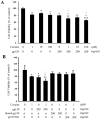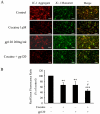Cocaine potentiates astrocyte toxicity mediated by human immunodeficiency virus (HIV-1) protein gp120
- PMID: 20976166
- PMCID: PMC2955538
- DOI: 10.1371/journal.pone.0013427
Cocaine potentiates astrocyte toxicity mediated by human immunodeficiency virus (HIV-1) protein gp120
Abstract
It is becoming widely accepted that psychoactive drugs, often abused by HIV-I infected individuals, can significantly alter the progression of neuropathological changes observed in HIV-associated neurodegenerative diseases (HAND). The underlying mechanisms mediating these effects however, remain poorly understood. In the current study, we explored whether the psychostimulant drug cocaine could exacerbate toxicity mediated by gp120 in rat primary astrocytes. Exposure to both cocaine and gp120 resulted in increased cell toxicity compared to cells treated with either factor alone. The combinatorial toxicity of cocaine and gp120 was accompanied by an increase in caspase-3 activation. In addition, increased apoptosis of astrocytes in the presence of both the agents was associated with a concomitant increase in the production of intracellular reactive oxygen species and loss of mitochondrial membrane potential. Signaling pathways including c-jun N-teminal kinase (JNK), p38, extracellular signal-regulated kinase (ERK)/mitogen-activated protein kinases (MAPK), and nuclear factor (NF-κB) were identified to be major players in cocaine and gp120-mediated apoptosis of astrocytes. Our results demonstrated that cocaine-mediated potentiation of gp120 toxicity involved regulation of oxidative stress, mitochondrial membrane potential and MAPK signaling pathways.
Conflict of interest statement
Figures







Similar articles
-
Cocaine and human immunodeficiency virus type 1 gp120 mediate neurotoxicity through overlapping signaling pathways.J Neurovirol. 2009 Apr;15(2):164-75. doi: 10.1080/13550280902755375. J Neurovirol. 2009. PMID: 19319745 Free PMC article.
-
Cocaine-mediated enhancement of Tat toxicity in rat hippocampal cell cultures: the role of oxidative stress and D1 dopamine receptor.Neurotoxicology. 2006 Mar;27(2):217-28. doi: 10.1016/j.neuro.2005.10.003. Epub 2005 Dec 28. Neurotoxicology. 2006. PMID: 16386305
-
Human immunodeficiency virus type 1 and its coat protein gp120 induce apoptosis and activate JNK and ERK mitogen-activated protein kinases in human neurons.Ann Neurol. 1997 Dec;42(6):847-56. doi: 10.1002/ana.410420605. Ann Neurol. 1997. PMID: 9403476
-
Macrophage activation through CCR5- and CXCR4-mediated gp120-elicited signaling pathways.J Leukoc Biol. 2003 Nov;74(5):676-82. doi: 10.1189/jlb.0503206. Epub 2003 Jul 22. J Leukoc Biol. 2003. PMID: 12960231 Review.
-
Cocaine and HIV-1 interplay in CNS: cellular and molecular mechanisms.Curr HIV Res. 2012 Jul;10(5):425-8. doi: 10.2174/157016212802138823. Curr HIV Res. 2012. PMID: 22591366 Free PMC article. Review.
Cited by
-
The effects of psychostimulant drugs on blood brain barrier function and neuroinflammation.Front Pharmacol. 2012 Jun 29;3:121. doi: 10.3389/fphar.2012.00121. eCollection 2012. Front Pharmacol. 2012. PMID: 22754527 Free PMC article.
-
Interleukin 10 mediated by herpes simplex virus vectors suppresses neuropathic pain induced by human immunodeficiency virus gp120 in rats.Anesth Analg. 2014 Sep;119(3):693-701. doi: 10.1213/ANE.0000000000000311. Anesth Analg. 2014. PMID: 25137003 Free PMC article.
-
Analysis of Sigma-1 Receptor Antagonist BD1047 Effect on Upregulating Proteins in HIV-1-Infected Macrophages Exposed to Cocaine Using Quantitative Proteomics.Biomedicines. 2024 Aug 23;12(9):1934. doi: 10.3390/biomedicines12091934. Biomedicines. 2024. PMID: 39335448 Free PMC article.
-
Astrocytes: Role in pathogenesis and effect of commonly misused drugs in the HIV infected brain.Curr Res Neurobiol. 2023 Aug 29;5:100108. doi: 10.1016/j.crneur.2023.100108. eCollection 2023. Curr Res Neurobiol. 2023. PMID: 38020814 Free PMC article. Review.
-
Psychostimulant Abuse and HIV Infection: cocaine, methamphetamine, and "bath salts" cathinone analogues.Curr Addict Rep. 2014 Sep 1;1(3):237-242. doi: 10.1007/s40429-014-0025-8. Curr Addict Rep. 2014. PMID: 26413453 Free PMC article.
References
-
- Cysique LA, Brew BJ. Neuropsychological functioning and antiretroviral treatment in HIV/AIDS: a review. Neuropsychol Rev. 2009;19:169–185. - PubMed
-
- Gray F, Adle-Biassette H, Chretien F, Lorin de la Grandmaison G, Force G, et al. Neuropathology and neurodegeneration in human immunodeficiency virus infection. Pathogenesis of HIV-induced lesions of the brain, correlations with HIV-associated disorders and modifications according to treatments. Clin Neuropathol. 2001;20:146–155. - PubMed
-
- Lee SC, Hatch WC, Liu W, Brosnan CF, Dickson DW. Productive infection of human fetal microglia in vitro by HIV-1. Ann N Y Acad Sci. 1993;693:314–316. - PubMed
-
- Tornatore C, Chandra R, Berger JR, Major EO. HIV-1 infection of subcortical astrocytes in the pediatric central nervous system. Neurology. 1994;44:481–487. - PubMed
-
- Anderson CM, Swanson RA. Astrocyte glutamate transport: review of properties, regulation, and physiological functions. Glia. 2000;32:1–14. - PubMed
Publication types
MeSH terms
Substances
Grants and funding
LinkOut - more resources
Full Text Sources
Other Literature Sources
Research Materials
Miscellaneous

